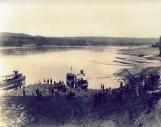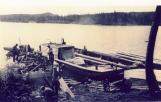1
The end of steam powered navigation was the result of several factors: the building of railways and road systems that allowed for better access to northern Alberta and British Columbia; the cost and inefficiency of operating steamboats; and the appearance of alternative technologies.Gasoline powered boats were to appear on the upper Peace River before the end of steam navigation. The first of these was the Beaver, owned by the Smoky & Peace River Co., launched on the Smoky River in 1914. This small boat was to operate on the Peace River until it was destroyed by fire in 1920.
2
The Beaver.Circa 1914-1916
Peace River Crossing, Alberta, Canada
 Credits:
Credits:Peace River Museum, Archives & Mackenzie Centre, 77.803.001
3
The Beaver, like other boats on the upper Peace River, pushed barges full of freight.4
The steam tug Beaver pushing a barge on the Peace River.Circa 1914-6
Peace River Crossing, Alberta, Canada
 Credits:
Credits:Peace River Museum, Archives & Mackenzie Centre, 73.531.022
5
Freight to be loaded into barges.Early 20th century
Peace River Crossing, Alberta, Canada
 Credits:
Credits:Peace River Museum, Archives & Mackenzie Centre, 87.1489.085
6
Another early gasoline powered boat was the Lady Mackworth, launched by the Peace River Development Corporation in 1916.7
The S.S. Lady Mackworth.1917
On the Peace River, Alberta, Canada
 Credits:
Credits:Peace River Museum, Archives & Mackenzie Centre, 77.799.002
8
The Beulah Boat Company was the creation of two boat builders and operators, Harry Weaver and George "Bud" Devore. Both were Americans (Weaver was from New York State and Devore was from Iowa) who arrived in Peace River during WWI. By 1915-6 both were using boats on the Peace River. In 1919, after leaving Peace River briefly, they returned to the community with only $300 in capital in the form of goods and a plan to build a boat to haul freight on the river.The plan led to the building of a small boat, the Beulah, which used a 12 hp. marine engine. This was followed by at least two other boats powered by marine engines, the Baby Beulah and the Beulah 3. While these boats were relatively small they could pull scows built by the Company, including one that could handle 20 tons in freight. The Company's focus in the 1920s was to haul freight and passengers to locations such as Hudson's Hope and Fort Vermilion. Goods were purchased from Revillon Brothers.
The Company's headquarters was a building and boat yards just south of the Heart River in the Town of Peace River. Their boats utilized a landing at the mouth of the Heart River and were anchored there when not in use. In general Harry Weaver was the boat operator while "Bud" Devore managed their business in Peace River and built new boats for their use.
In the 1930s the focus of the Company's operations switched to supplying prospectors on Great Bear Lake. Boats were built at their Peace River boatyard and left in the north on the completion of their trips. the last of their boats, the Beulah 3, was sold in 1936 and the two owners built a store in Yellowknife, ending the Beulah Boat Company.
The Beulah Boat Company's success in competing with large steamboats (owned by the Hudson's Bay Company) in the 1920s reveals several of the weaknesses of the use of steam technology. Two men with boat building skills and limited resources were able, as noted above, to quickly get into business. Their operating costs were low, given the need for large volumes of wood and crews on steamboats. The boats of the Beulah Boat Company were shallow draft and could handle low water levels that might ground a larger steamboat such as the S.S. D.A. Thomas. In the end the Beulah Boat Company's ability to take on large loads of freight in scows and to make frequent trips greatly cut into the profit margins of the Hudson's Bay Company and its steamboats.
9
Another early arrival of non-stem technology was the Beulah Boat Company which started to build and operate boats at Peace River Crossing in 1920.10
The Beulah Boat Company building.Circa 1920s
Peace River Crossing, Alberta, Canada
 Credits:
Credits:Peace River Museum, Archives & Mackenzie Centre, Don Weaver Fonds
11
Beulah Boat Company landing area, Peace River.Circa 1920s
Peace River Crossing, Alberta, Canada
 Credits:
Credits:Peace River Museum, Archives & Mackenzie Centre, Don Weaver Fonds.
12
Examples of the Beulah Boat.Circa 1920s
Peace River Crossing, Alberta, Canada
 Credits:
Credits:Peace River Museum, Archives & Mackenzie Centre, Don Weaver Fonds.
13
Boats at the Beulah Boat Company landing area.Circa 1920s
Peace River Crossing, Alberta, Canada
 Credits:
Credits:Peace River Museum, Archives & Mackenzie Centre, Don Weaver Fonds